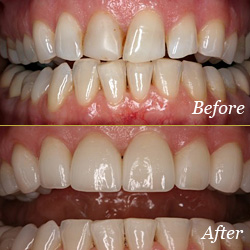We truly care about your dental health

Bonding
Bonding is a conservative way to repair slightly chipped, discolored, or crooked teeth.
During dental bonding, a white filling is placed onto your tooth to improve its appearance. The filling "bonds" with your teeth, and because it comes in a variety of tooth-colored shades, it closely matches the appearance of your natural teeth.
Tooth bonding can also be used for teeth fillings instead of amalgam fillings. Many patients prefer bonding fillings because the white color is much less noticeable than the silver amalgam fillings. Bonding fillings can be used on front and back teeth depending on the location and extent of tooth decay.
Bonding is less expensive than other cosmetic treatments and usually can be completed in one visit to our office. However, bonding can stain and is easier to break than other cosmetic treatments such as porcelain veneers. If it does break or chip, tell Dr. Whitfield. The bonding can generally be easily patched or repaired in one visit.
Bridges
A bridge may be used to replace missing teeth, help maintain the shape of your face, and alleviate stress in your bite.
A bridge replaces missing teeth with artificial teeth, looks great, and literally bridges the gap where one or more teeth may have been. Your bridge can be made from gold, alloys, porcelain, or a combination of these materials and is bonded onto surrounding teeth for support.
The success of any bridge depends on its foundation — the other teeth, gums, or bone to which it is attached. Therefore, it's very important to keep your existing teeth, gums, and jaw healthy and strong.


Crowns
Crowns are a cosmetic restoration used to improve your tooth's shape or to strengthen a tooth.
Crowns are most often used for teeth that are broken, worn, or have portions destroyed by tooth decay.
Crowns are "caps" cemented onto an existing tooth, which fully cover the portion of your tooth above the gum line. In effect, the crown becomes your tooth's new outer surface. Crowns can be made of porcelain, metal, or both. Porcelain crowns are most often preferred because they mimic the translucency of natural teeth and are very strong.
Crowns are often preferable to silver amalgam fillings. Unlike fillings which apply metal directly into your mouth, a crown is fabricated away from your mouth. Your crown is created in a lab from your unique tooth impression, which allows a dental laboratory technician to examine all aspects of your bite and jaw movements. Your crown is then sculpted just for you so that your bite and jaw movements function normally once the crown is placed.
Fillings
Traditional dental restoratives (fillings) include gold, porcelain, and composite/amalgam.
The strength & durability of traditional dental materials continue to make them useful for situations where restored teeth must withstand extreme forces that result from chewing, such as in the back of the mouth
Newer dental fillings include ceramic & plastic compounds that mimic the appearance of natural teeth. These compounds, often called composite resins, are usually used on the front teeth where a natural appearance is important. They can be used on the back teeth as well depending on the location and extent of the tooth decay. Composite resins are usually more costly than the traditional silver amalgam fillings.
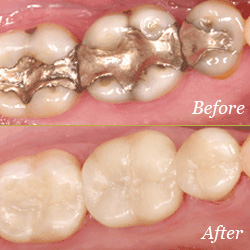
What's Right for Me?
Several factors influence the performance, durability, longevity and expense of dental restorations:
- The components used in the filling material
- The amount of tooth structure remaining
- Where and how the filling is placed
- The chewing load that the tooth will have to bear
- The length and number of visits needed to prepare and adjust the restored tooth
The ultimate decision about what to use is best determined in consultation with your doctor. Before your treatment begins, discuss the options with Dr. Whitfield.
Types of Fillings
To help you prepare for this discussion it is helpful to understand the two basic types of dental fillings: direct and indirect.
Direct fillings are fillings placed immediately into a prepared cavity in a single visit. They include dental amalgam, glass ionomers, resin ionomers, and composite (resin) fillings. Dr. Whitfield prepares the tooth, places the filling, and adjusts it during one appointment.
Indirect fillings generally require two or more visits. They include inlays, onlays, veneers, crowns, and bridges fabricated with gold, base metal alloys, ceramics, or composites. During the first visit, Dr. Whitfield prepares the tooth and makes an impression of the area to be restored. Dr. Whitfield then places a temporary covering over the prepared tooth. The impression is sent to a dental laboratory which creates the dental restoration. At the next appointment, Dr. Whitfield cements the restoration into the prepared cavity and adjusts it as needed.
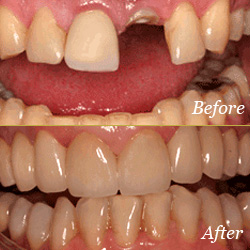
Dental Implants
If you have missing teeth, it is crucial to replace them.
Without all your teeth, chewing and eating can destabilize your bite and cause you discomfort. When teeth are missing, your mouth can shift and even cause your face to look older. Implants are a great way to replace your missing teeth.
An implant is a new tooth made of steel and porcelain that looks just like your natural tooth. Your implant is composed of two parts that mimic a tooth's root and crown. The implant's "root" is a titanium steel rod placed into the jawbone to act as a root. Once the rod is in place, a porcelain crown is attached to replace the top part of your tooth.
Implants may also be used to anchor dentures, especially lower dentures that tend to shift when you talk or chew; and for patients with removable partial dentures, implants can replace missing teeth so that you have a more natural-looking smile.
Invisalign - Invisible Aligners
Dr. Whitfield is a Certified Invisalign® Provider.
Consider Invisalign to get the beautiful straight teeth you've always wanted — without braces. A complimentary consultation with Dr. Whitfield can determine if Invisalign is right for you.
What is it?
Invisalign uses a series of invisible, removable, and comfortable aligners that no one can tell you're wearing; so, you can smile more during treatment as well as after. Invisalign is made with 3D computer imaging technology and has been proven effective. More than 70% of orthodontists in the US and Canada are certified to treat with Invisalign.
Why would I want it?
Not only are the aligners invisible, they are removable, so you can eat and drink what you want while in treatment; plus, brushing and flossing are no problem. The aligners are also comfortable, with no metal to cause mouth abrasions during treatment, and no metal and wires usually means you spend less time in your doctor's office getting adjustments. Invisalign also allows you to view your own virtual treatment plan when you start so you can see how your straight teeth will look when your treatment is complete.
How does it work?
You wear each set of aligners for about 2 weeks, removing them only to eat, drink, brush, and floss. As you replace each aligner with the next in the series, your teeth will move — little by little, week by week — until they have straightened to the final position Dr. Whitfield has prescribed. You'll visit Dr. Whitfield about once every 6 weeks to ensure that your treatment is progressing as planned. Total treatment time averages 9-15 months and the average number of aligners worn during treatment is between 18 and 30, but both will vary from case to case.
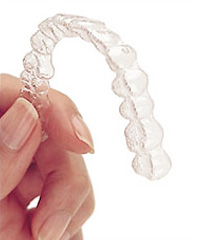

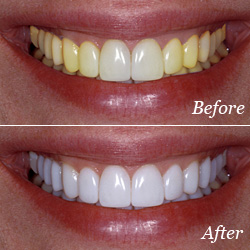
Teeth Whitening
Everybody loves a bright white smile, and there are a variety of products & procedures available to help you improve the look of yours.
Many people are satisfied with the sparkle they get from brushing twice daily with fluoride toothpaste, flossing once a day, and the regular cleanings at the dentist's office. However, if you decide you would like to go beyond this to make your smile look brighter, you should investigate all of your options.
Finding the Best Treatment for You
Schedule a visit with us to learn whether whitening procedures would be effective for you. Whiteners do not correct all types of discoloration. For example, yellowish teeth will probably bleach well, brownish teeth may bleach less well, and grayish teeth may not bleach well at all. Likewise, whitening may not enhance your smile if you have had tooth-colored fillings or crowns. The whitener will not affect the color of these materials, and they will stand out in your newly whitened smile. In these cases, you do have other options such as porcelain veneers.
Tooth Whitening Treatments
- Professional teeth whitening with your doctor
- At-home whitening system (tray-based or whitening strips)
- Whitening toothpaste
Dental Veneers
There's no reason to put up with gaps in your teeth or with teeth that are stained, discolored, badly shaped, chipped, or crooked.
Today, a veneer placed on top of your teeth can correct nature's mistake, or the results of an injury, and help you have a beautiful smile. Veneers are a highly popular solution among dental patients because of their life-like tooth appearance.
Veneers are thin, custom-made shells crafted of tooth-colored materials (such as porcelain) designed to cover the front side of your teeth. To prepare for veneers, Dr. Whitfield will create a unique model of your teeth. This model is sent to the dental technician to create your veneers. Before placing your new veneer, Dr. Whitfield will remove a small amount of your tooth to make room for the veneer.
When placed, you'll be pleased to see that veneers look like your natural teeth and even resist staining. Though veneers are stain resistant, Dr. Whitfield may recommend that you avoid coffee, tea, red wine, and tobacco to maintain the beauty of your veneer.
